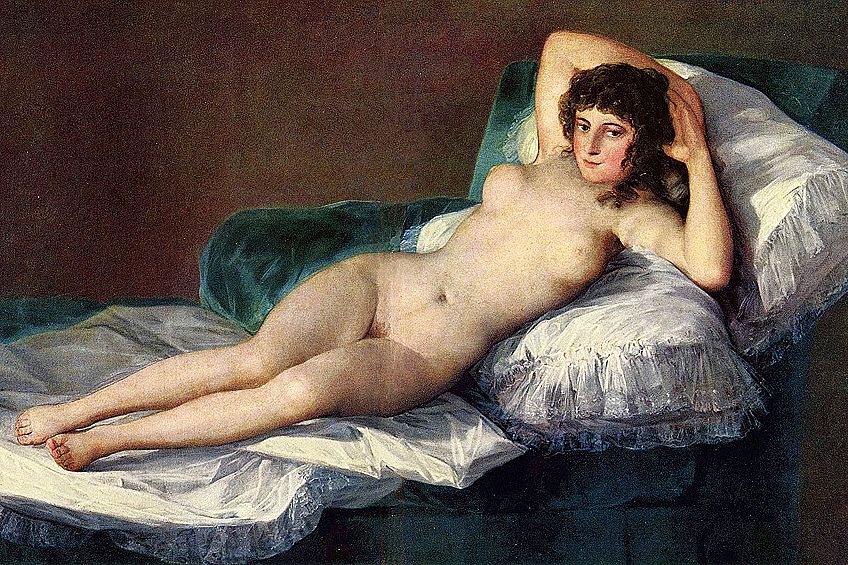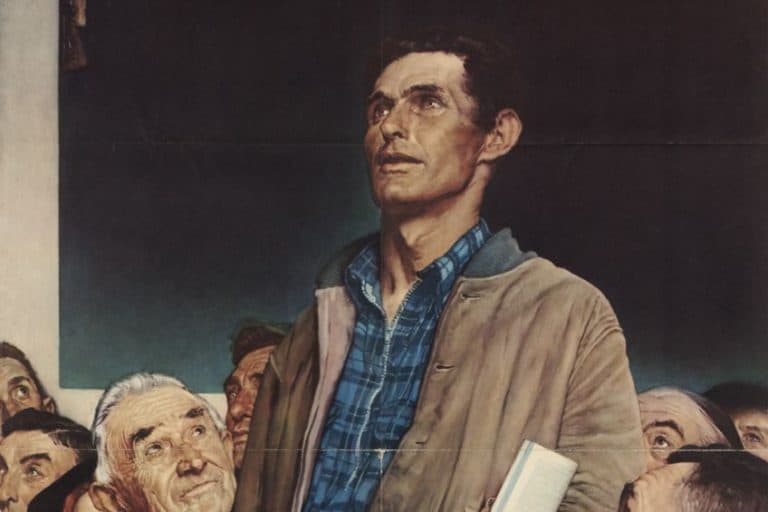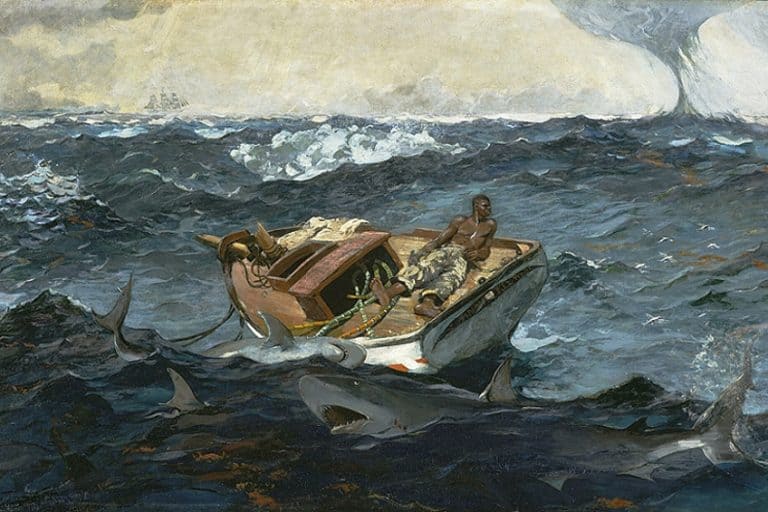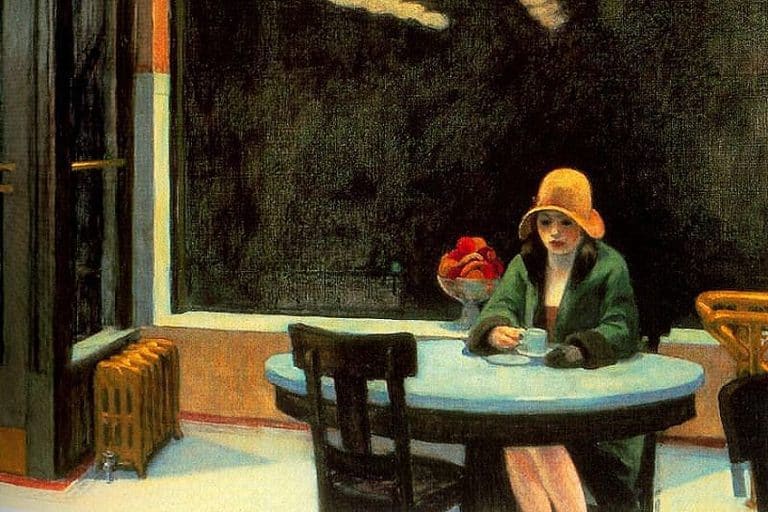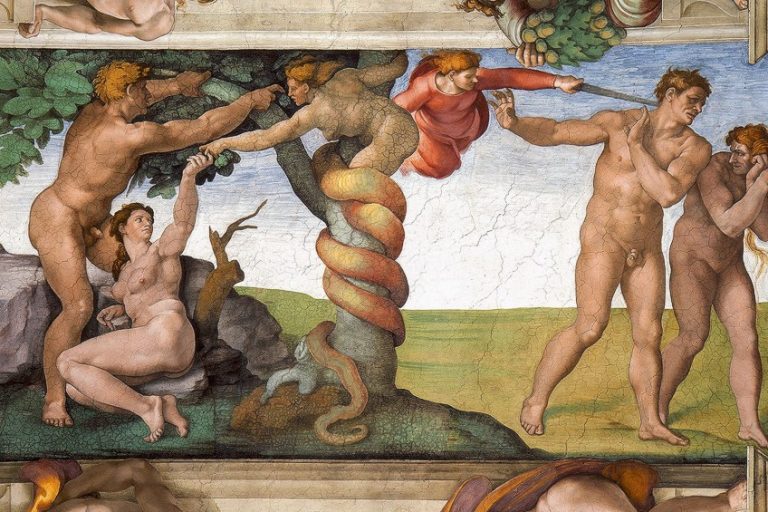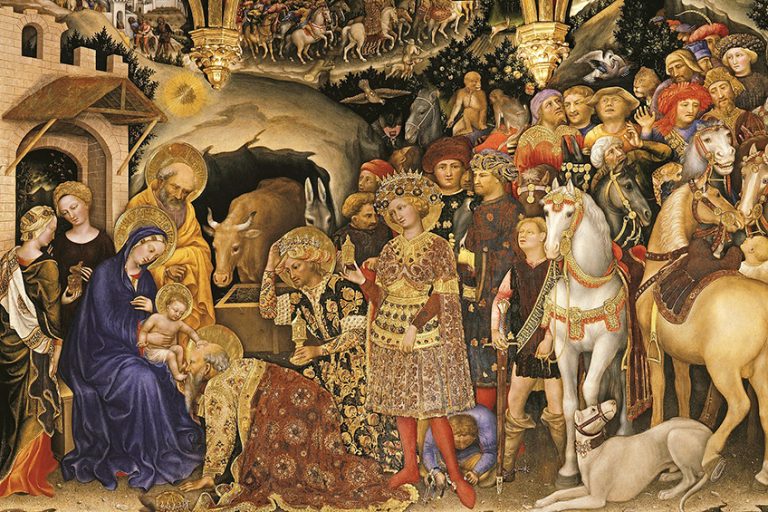“The Naked Maja” by Francisco Goya – A Painting Analysis
From being privately hidden during the Spanish Inquisition to being depicted on postage stamps and becoming iconic in 20th century pop culture, The Naked Maja (c. 1795 – 1800) by Francisco Goya has been a controversial and celebrated painting for centuries. Read more as the article below discusses this oil on canvas, and analyzes how Goya depicted a nude as close to realistically possible and further from fantasy.
Artist Abstract: Who Was Francisco Goya?
Francisco José de Goya y Lucientes, otherwise known as Francisco de Goya or just Francisco Goya, was born in the Spanish village called Fuendetodos. His date of birth was on March 30, 1746, and he died on April 16, 1828, in Bordeaux, France. He is famously and widely described as “one of the last Old Masters” and one of the “first modern artists”. His studies in art began as early as 14 years old and he learned from Baroque artists like José Luzán and Anton Raphael Mengs. He was a court painter for King Charles III and King Charles IV. Some of his famous artworks include The Sleep of Reason Produces Monsters (c. 1797), The Third of May, 1808 (1814), and Saturn Devouring His Son (c. 1821 – 1823).
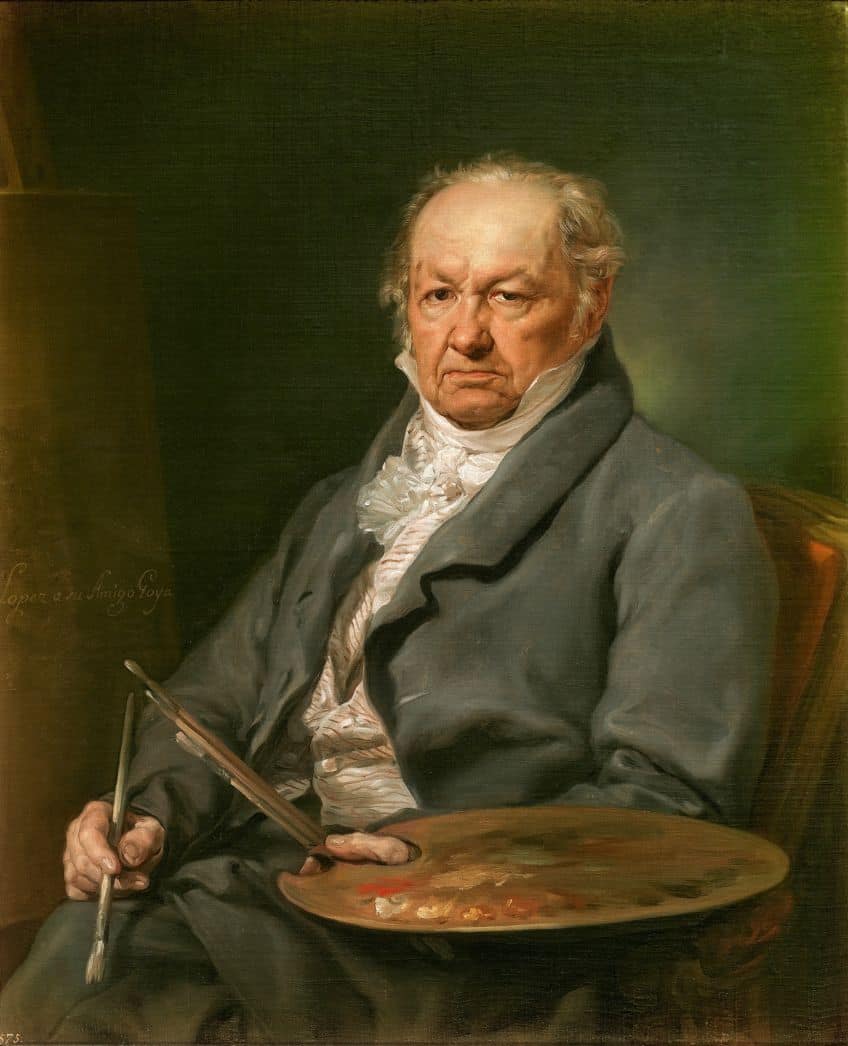
The Naked Maja (c. 1795 – 1800) by Francisco Goya in Context
| Artist | Francisco de Goya (1746 – 1828) |
| Date Painted | c. 1795 – 1800 |
| Medium | Oil on canvas |
| Genre | Portrait painting |
| Period/Movement | Romanticism |
| Dimensions (meters) | 97.3 x 190.6 |
| Series/Versions | There is another version of the model clothed, which is titled La Maja Vestida (c. 1800 – 1807). This is also housed at the Museo Nacional del Prado in Madrid, Spain. |
| Where Is It Housed? | Museo Nacional del Prado, Madrid, Spain |
| What It Is Worth | The price is uncertain. Both paintings have been part of the Museo Nacional del Prado since 1901. |
The Naked Maja by Francisco Goya, otherwise known as La Maja Desnuda, depicts an unabashed and realistic portrayal of a reclining female nude, of which the origins will be discussed in a contextual analysis below. A formal analysis will look at the stylistic details of the artwork including a visual description of the subject matter, mainly the maja, and of the art elements and how they are utilized to create the composition.
Contextual Analysis: A Brief Socio-Historical Overview
From being commissioned to being questioned, The Naked Maja, by Francisco Goya, has had an eventful life as a painting since its creation over 200 years ago. A maja was a lower-class Spanish woman known to decorously act and dress. The masculine term is “majo”. Let us start from the beginning, for who it was painted, who was painted, and how it was privately displayed.
The details around who exactly commissioned The Naked Maja painting are unclear, but it has been attributed to possibly being a commission for the Spanish Prime Minister, Manuel de Godoy, whom Goya was reportedly also acquaintances with. Additionally, Goya also painted other portraits of Manuel de Godoy.
An example includes the oil on canvas titled Portrait of Manuel Godoy (1801), which is housed at the Real Academia de Bellas Artes de San Fernando in Madrid, Spain.
The details around who was painted are also murky, and there are two women who may have been the models for The Naked Maja by Francisco Goya. These are, namely, María Teresa de Silva, 13th Duchess of Alba, who possibly had a relationship with Goya, or Josefa de Tudó, known also as Pepita Tudó, who was Manuel de Godoy’s mistress.
The Naked Maja painting reportedly hung in Manuel de Godoy’s private study with another painting titled The Rokeby Venus (1647 – 1651) by the Spanish artist Diego Velázquez, which is at the National Gallery in London, England.
The Rokeby Venus is often mentioned as being a part of Manuel de Godoy’s private study and hung with Goya’s nude and clothed maja paintings. It depicts the Roman goddess, Venus, reclining in the nude with her back to us, the viewers. She is looking into a mirror held up by Cupid, which reveals her face to us.

Why Were These Paintings in a Private Study?
The Naked Maja, along with The Rokeby Venus, were nude paintings, of which Goya’s painting depicted female genitalia, notably her pubic hair. This was also a controversial depiction of a nude because it held more realism and overtly suggested a sexual nature compared to the more bashful depictions of female figures from Classical mythology.
It was also illegal to keep nude paintings in Spain. This was by order of the Catholic Church which banned any nude paintings because they were lustful and tempting. These bans reportedly led people to hide nude paintings in private collections.
However, during the Spanish Inquisition, in 1815, Goya was called by the Secret Chamber of the Inquisition in Madrid and questioned about the nature of his nude and clothed maja.
He was reportedly asked about who commissioned them and why he painted them. He was reportedly not persecuted, and the reasons related to him only imitating more classical nudes and the so-called tradition of nude paintings, which were already in standing with the authorities.
Not too long before this, in 1808, Manuel de Godoy and Don Francisco de Garivay, who was the curator of the paintings, were also questioned about the possession of the nude paintings and who the painter was, of which they said it was Goya, which led to his questioning.

Formal Analysis: A Brief Compositional Overview
The formal analysis will focus on The Naked Maja painting, and it will discuss a visual description of the artwork, taking a closer look at how Goya painted the subject matter. There will also be mention of The Clothed Maja for the purpose of comparison between the two paintings. It will also discuss the artistic approach in terms of how the elements of art compose or create the painting, but also how they are arranged, which relates to what principles of art are utilized.
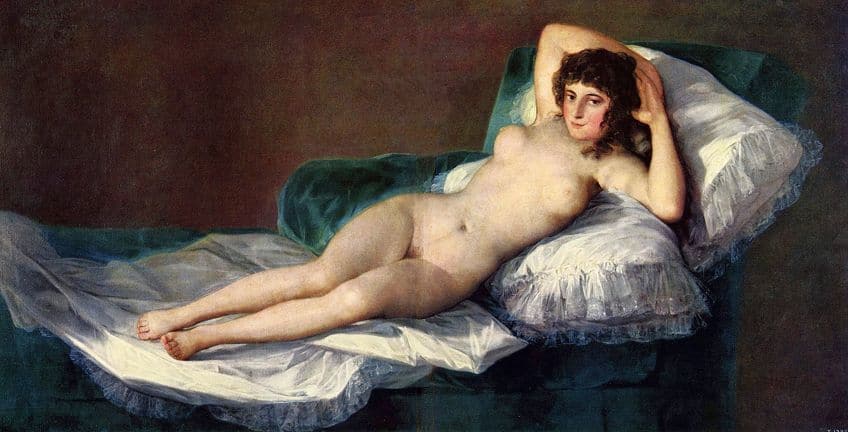
Subject Matter: Visual Description
The Naked Maja painting depicts the central subject, which is the figure of a curly-haired brunette maja. She is in a reclining pose, partially on her back and on her left side. She is directly facing us, the viewers, with a confident and unwavering stare, a soft smile, and blushing cheeks.
Her arms are held up and her hands are loosely resting behind her head, her right hand is over her left hand.
This opens her posture more. Her right leg is partially over her left leg, and both legs are slightly bent at the knees. Her genitalia are hidden only revealing her pubic hair. The Maja is lying on a dark green velvet-covered chaise longue on a soft, almost translucent, lace cover and what appears to be two pillows nestled behind her back and head. The background appears brown, which could be a wall behind the maja and there are no other visible objects.
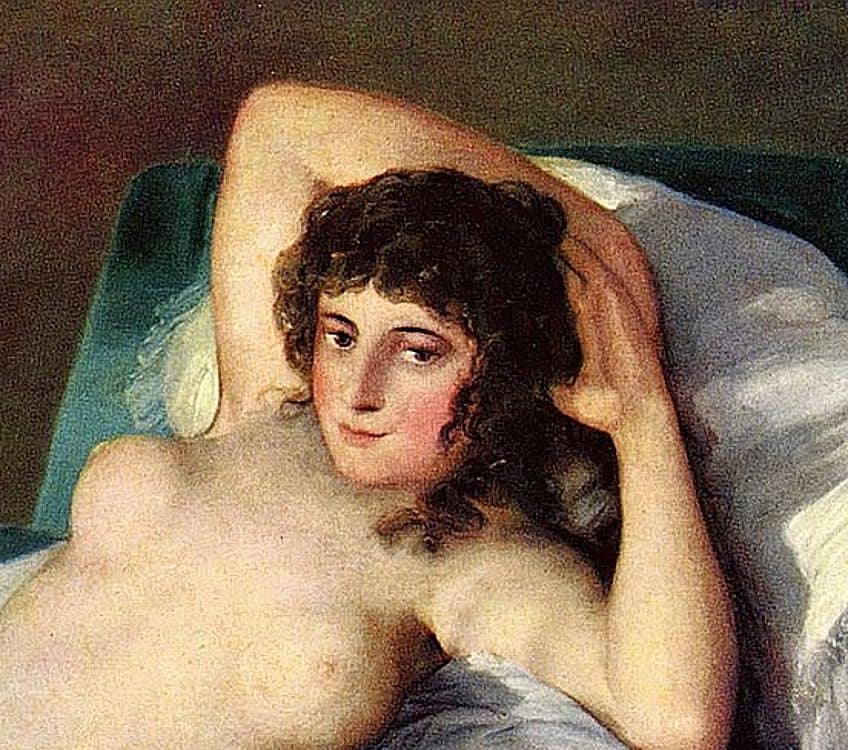
The Clothed Maja
In The Clothed Maja painting, Goya depicts a similar setting, but here the maja wears a long white lace dress with a light pink sash around her waist. She is wearing a patterned mustard-yellow black jacket and golden pointed shoes with what appears to be white stockings underneath. Her hands are also behind her back and head, and she shares the same unabashed stare as her nude version.
The chaise longue is also green with white silky, or lace covers and pillows underneath the maja.
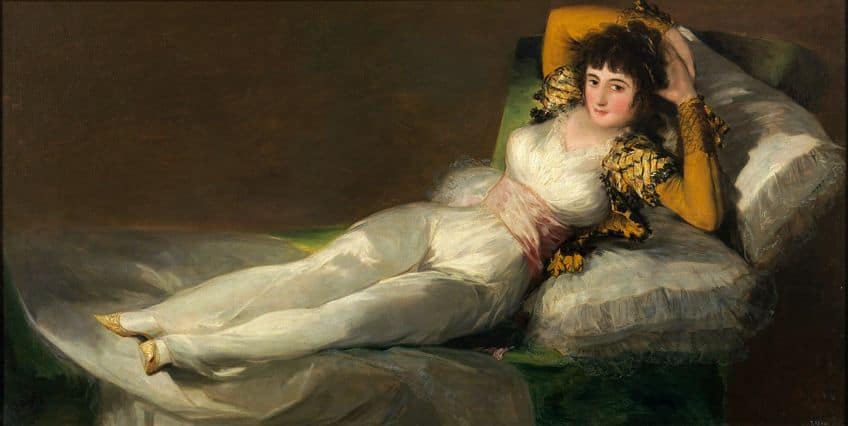
Color
The color scheme in The Naked Maja consists of dark colors and there are shadowed areas with an area of light on the maja’s figure as if there is an unknown light source. This places the focus on her as the main focal point. A contrast is created through the lighter and darker colors, for example, the background appears dark, almost a black-brown color, along with the darker green of the chaise longue.
The lighter colors are the whites of the bedding and the maja’s fair skin tone, along with the lighter reds of her cheeks.

Texture
There is a combination of implied and tactile textures in The Naked Maja painting, for example, the soft almost silken textures of the bedding’s lace-like fabric and the smoother and sheen appearance of the velvet. Also, notice the smooth texture of the maja’s skin and the soft curled locks of her hair. Tangible textures of Goya’s brushwork are evident on the canvas.
These are notable on the bedding’s fabric, which appear in a variety of brushstrokes, from short, thick, long, and short strokes, including dabs, to create the appearance of the bedding’s folds and finer frills.
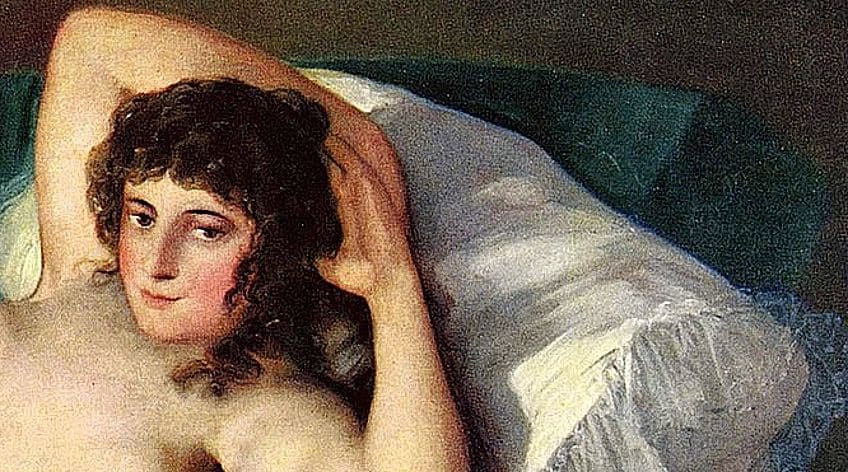
Line
The type of lines that delineate The Naked Maja painting consists mostly of organic or naturalistic lines. These appear freer flowing with natural curves, for example, the maja’s almost S-like curve of her figure. These are partly offset with the more angular lines from the chaise longue backrest to the right.
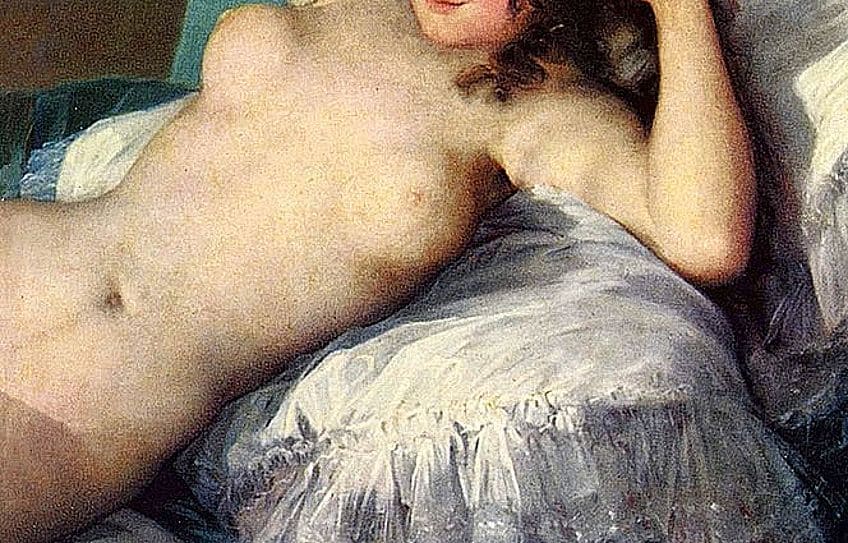
Space
Francisco Goya fills the compositional space with the chaise longue and the maja reclining on it. This fills the immediate foreground with part of the chaise longue cut off. The background is an empty space, and its dark color creates a backdrop effect.
It also creates a somewhat two-dimensional space as there is minimal depth indicated between the background and the maja’s figure.
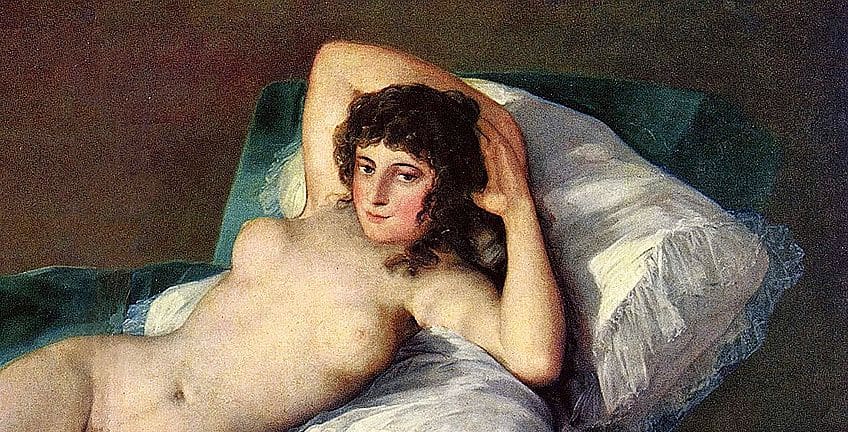
Shape and Form
Like the lines mentioned above, the types of shapes and forms are also naturalistic, notably the maja’s figurative form. There is a square-like shape evident on the backrest of the chaise longue, which appears almost like an L-shape on its side.
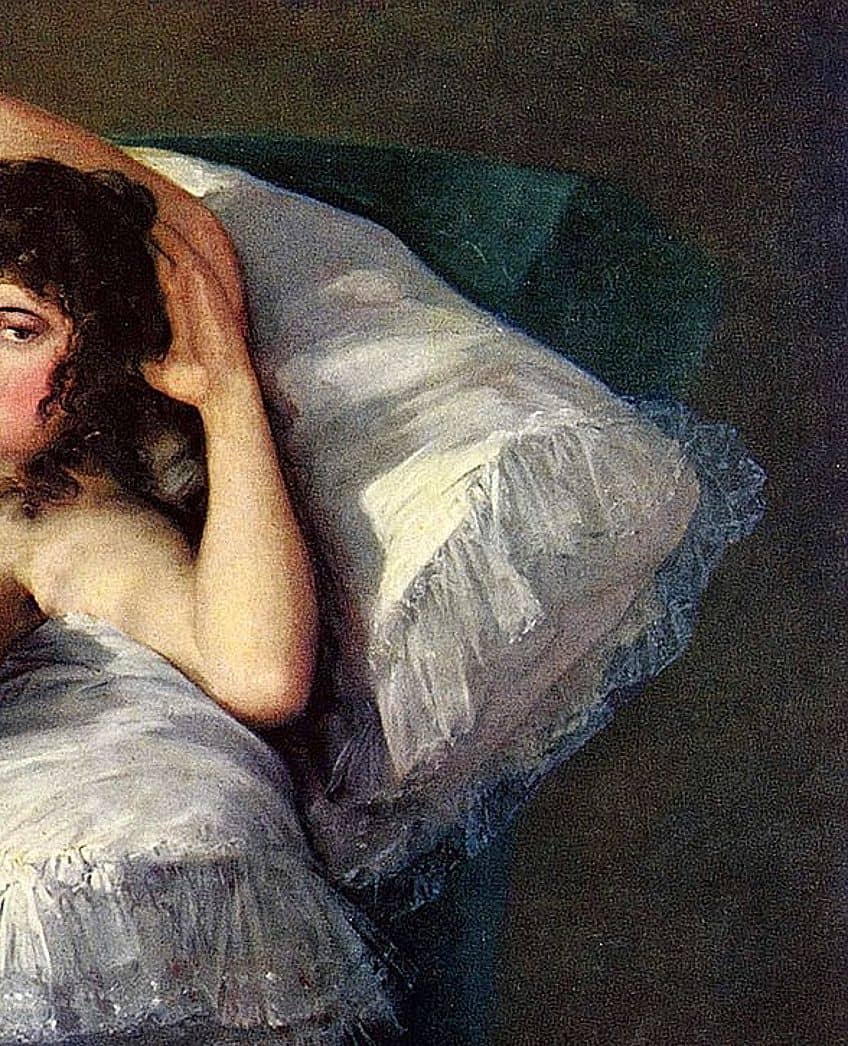
A Maja Immortalized
The Naked Maja by Francisco Goya outlasted the Spanish Inquisition and found her way into the modern centuries, notably on postage stamps from 1930, several films, and a book similarly titled by Samuel Edwards from 1959. She is now in the Museo Nacional del Prado in Madrid, Spain, with her clothed twin, where they have both been from 1901. Francisco Goya’s nude maja is an example of a painting that pushed the boundaries of how nude females were portrayed in portraits. It influenced the later Impressionist painting titled Olympia (1863) by Édouard Manet.

From portrayals of mythological and bashful nudes to unwavering women owning their position in the nude – Goya’s “The Naked Maja” has been immortalized as an icon of female nudity. It still evokes multitudes of questions about who she is and what she means within the broader context of what the female nude represents in art.
Frequently Asked Questions
Who Painted The Naked Maja?
The oil on canvas, The Naked Maja (c. 1795 – 1800), was painted by Francisco de Goya, who was a Spanish Romanticism artist. The painting is at the Museo Nacional del Prado in Madrid, Spain.
Who Commissioned The Naked Maja Painting?
Francisco de Goya’s painting, The Naked Maja (c. 1795 – 1800), is believed to have been commissioned by Manuel de Godoy, who was the Spanish Prime Minister on two occasions, from 1792 to 1797 and 1801 to 1808. He also commissioned Goya to create other artworks for him.
Is There a Clothed Maja Painting by Francisco Goya?
There are two versions of Francisco de Goya’s painting depicting a female maja. These are, namely, The Naked Maja (c. 1795 – 1800), known as La Maja Desnuda in Spanish, and The Clothed Maja (c. 1800 – 1807), or La Maja Vestida in Spanish.
Alicia du Plessis is a multidisciplinary writer. She completed her Bachelor of Arts degree, majoring in Art History and Classical Civilization, as well as two Honors, namely, in Art History and Education and Development, at the University of KwaZulu-Natal, South Africa. For her main Honors project in Art History, she explored perceptions of the San Bushmen’s identity and the concept of the “Other”. She has also looked at the use of photography in art and how it has been used to portray people’s lives.
Alicia’s other areas of interest in Art History include the process of writing about Art History and how to analyze paintings. Some of her favorite art movements include Impressionism and German Expressionism. She is yet to complete her Masters in Art History (she would like to do this abroad in Europe) having given it some time to first develop more professional experience with the interest to one day lecture it too.
Alicia has been working for artincontext.com since 2021 as an author and art history expert. She has specialized in painting analysis and is covering most of our painting analysis.
Learn more about Alicia du Plessis and the Art in Context Team.
Cite this Article
Alicia, du Plessis, ““The Naked Maja” by Francisco Goya – A Painting Analysis.” Art in Context. September 19, 2023. URL: https://artincontext.org/the-naked-maja-by-francisco-goya/
du Plessis, A. (2023, 19 September). “The Naked Maja” by Francisco Goya – A Painting Analysis. Art in Context. https://artincontext.org/the-naked-maja-by-francisco-goya/
du Plessis, Alicia. ““The Naked Maja” by Francisco Goya – A Painting Analysis.” Art in Context, September 19, 2023. https://artincontext.org/the-naked-maja-by-francisco-goya/.


